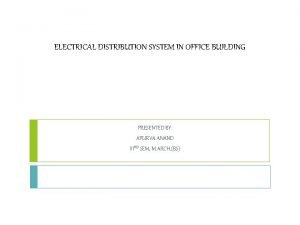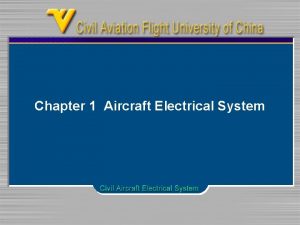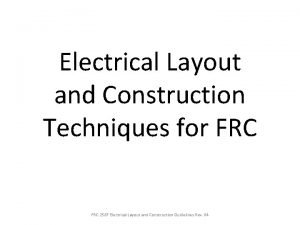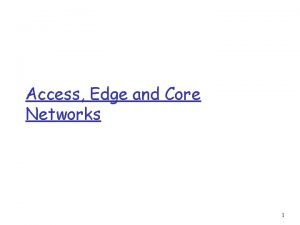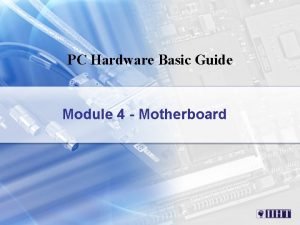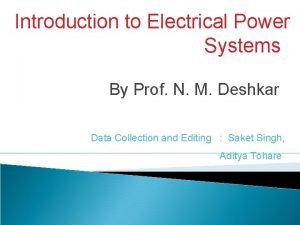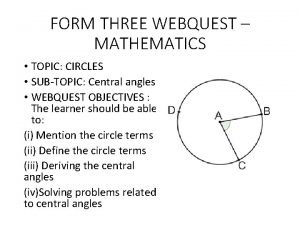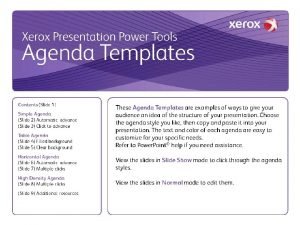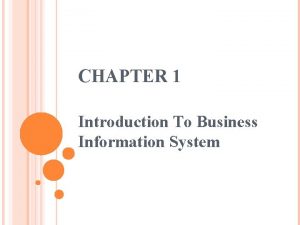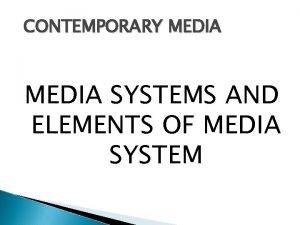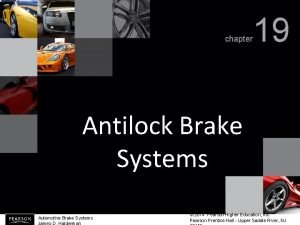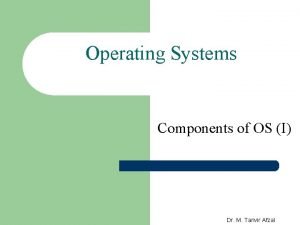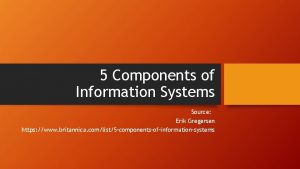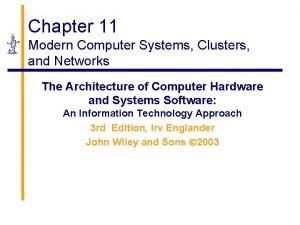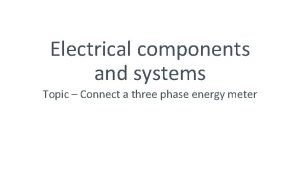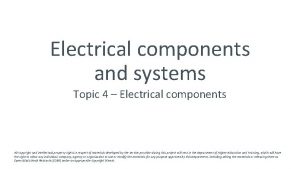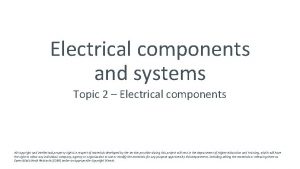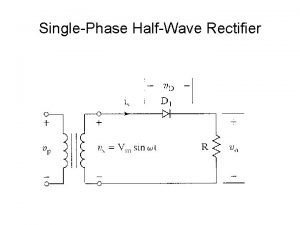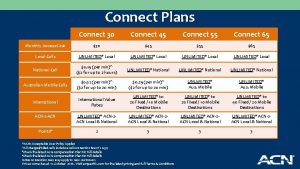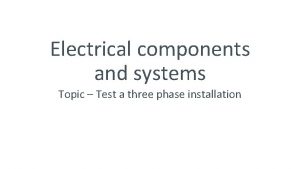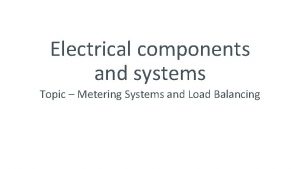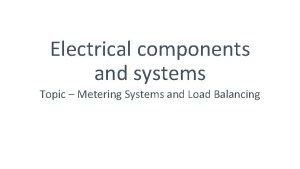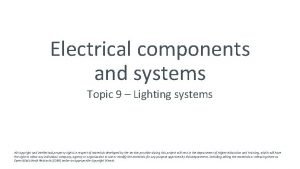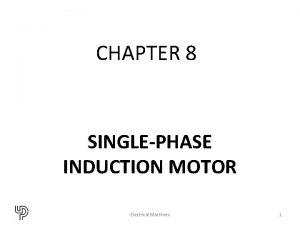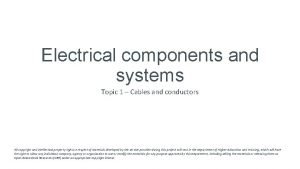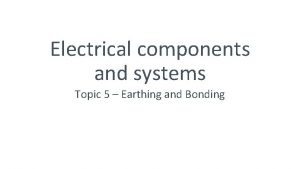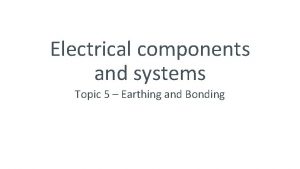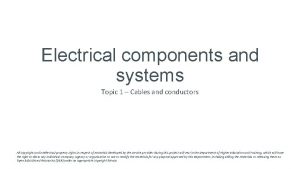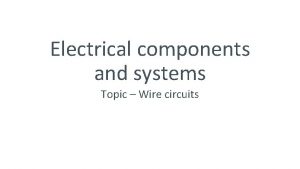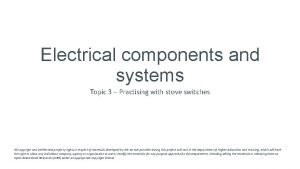Electrical components and systems Topic Connect three singlephase


























- Slides: 26

Electrical components and systems Topic – Connect three single-phase energy meters

Connect three single-phase energy meters Unit 7. 5

Assumed prior learning Using energy meters Connect a single-phase energy meter Connect a three-phase energy meter Wire a three-phase balanced load • Don’t feel confident yet about these topics? Click on each to review the content. • Feeling confident? Click next to proceed with this unit.

Outcomes • Wire a given panel so that the energy meters will correctly measure the power consumed.

Introduction Every household, business or industry needs electricity and in order to measure power consumption energy meters are installed in all types of establishments. In this lesson we look at connecting three, single-phase energy meters to measure power consumption.

Supplying power to a consumer When a house or industry is supplied with electricity, the connections are made in a certain order. Click on each number in the image to learn about the process of power supply to consumers. 3 1 2

Order of the supply to the circuit The order of arrangement of the supply to the consumer’s circuit is as follows: - The supply authority’s service mains. - The supply authority’s main fuses or other protective device. - The supply authority’s meters. - Main distribution boards. - Sub-distribution boards. Each component of the above arrangement will be discussed.

Service mains, protective devices and meters • The mains are either underground cables or overhead lines, which carry the supply power from the substation to a kiosk, usually situated on the pavement next to the consumer’s premises. The supply authority terminates their service mains in these kiosks. • The supply authority’s main circuit breakers and energy meters are located in this kiosk. • From the energy meters, cables are laid to the house where they terminate in connection boxes that are mounted on the outside wall of the house. • The consumer installs conductors from this connection box to the main distribution board in his house.

Consumer’s main distribution board • The consumer has a main switch or circuit breaker mounted in a distribution board. • The main circuit-breaker’s value is usually 10 amps smaller than the supply authority’s, which is mounted in the kiosk outside the building. • Circuit-breakers, which supply the power to the lighting, plugs, geysers, stove and bell circuits are mounted on the distribution board.

Sub-main distribution boards, which in turn are supplied from the main distribution board, are only used in very large houses, hotels, blocks of flats and factories where one distribution board is too small to facilitate all the protective devices. The above background serves as an introduction for this lesson on connecting energy meters in the supply line from the supply authority to the consumer. Note that instead of using a distribution board a contactor, timer and a load is mounted on the panel and a three-phase power supply is used.

Connecting energy meters The wiring diagram shows the layout of a circuit containing the necessary equipment to practise wiring the consumer’s circuits to the supply authority’s power supply in the correct order. All panels are not set out the same way but the order of connections will always be the same.

Method to wire the panel The main circuit • Determine the current that will be drawn by the load because this current will determine the size of the conductor to be used and also the ratings of the disconnectors (fuses etc. ). • Wire to the top of the supply authority’s main circuit-breaker. This is a three-phase supply and it is suggested that red, white and blue conductors be used from left to right in that order. • Wire from the bottom of the supply authority’s circuit- breaker to the left-hand connection of the supply authority’s meters. • It is standard procedure to connect the supply line on the left-hand side, and to the load line from the right hand side connection of any energy meter.

Method to wire the panel (continued) • Wire from the right hand connection of the meters to the bottom of the consumer's main circuit breaker. • Wire from the “load” side of the contactor to the load. • Wire the supply authority’s neutral bar to one of the centre terminals of the nearest meter. The other centre terminal loop must then be wired to the next meter and so on until all the meters have a neutral conductor. • Wire from the supply authority’s neutral bar to the consumer’s neutral bar.

Method to wire the panel (continued) • The phasing of the panel must at all times be the same, that is, keep the red conductor on the left, the white in the centre and the blue on the right side. Maintaining this order of colours will prevent any cross-phasing between the equipment.

Method to wire the panel (control circuit) The control circuit for the consumer’s contactor is the same as that of a direct-on-line starter where a stop-start button, or a timer switch is used. Refer back to Connecting and Starting Three Phase AC Motors, if necessary. The main and control circuits are shown in the wiring diagrams contained in that unit.

Method to wire the panel (control circuit continued) The time switch operates on the same principle as an electric clock. Click on the image for more information

Earthing All the metal casings on the board must be earthed. The earthing must comply with the SANS Code of Practice for the Wiring of Premises (Regulation 6. 12). • Note: Test the complete installation and correct any faults that may be found, before switching on the power supply. • Check to ensure that the energy meters are registering the power consumption correctly.

Assessment criteria You will have a practical assessment, which must be completed without using references other than current rating tables. • You will be provided with a wiring diagram, a three-phase supply and a panel with all the components and equipment (energy meters etc. ) mounted on it, and must wire the panel according to the following standards: (a) The panel must be wired according to the wiring diagram. (b) The circuit must be wired according to the order of arrangement as set out here. (c) If a consumer’s time switch is used it must be arranged so that the load can be switched “on” or “off” at a pre-set time. (d) The energy meters must correctly register the power consumed. (e) The wiring of the panel, the selection of the sizes and colours of the conductors and the termination of conductors, must be according to the standards described in Wiring a panel and the SANS Code of Practice for the Wiring of Premises. (f) All the metal parts must be earthed.

Practise • Use the appropriate circuit diagrams, and wire the given panels according to the procedures described in the lesson. • Test each completed installation before switching on the power supply. • Check whether the energy meters are registering the power consumption correctly. • REMEMBER to adhere to all the relevant safety procedures when doing the practical work. Refer to the HIAC Form.

Quiz time We have come to the end of this unit. Answer the following questions to make sure you understand how to connect three single-phase energy meters.

Question 1 Order the following in the correct arrangement to connect the power supply from the supplier to the consumer’s circuit (drag and drop to rearrange). A) The supply authority’s meters. B) The supply authority’s service mains. C) Main distribution boards. D) The supply authority’s main fuses or other protective device. E) Sub-distribution boards.

Question 2 Where is the consumers main switch or circuit breaker mounted? INSERT YOUR ANSWER HERE.

Question 3 The time switch operates on the same principle as an electric clock. TRUE Click on the correct answer. FALSE

Let’s review: In this lesson we have covered: üHow power is supplied and distributed to consumers. üConnecting energy meters. üMethod to wire a panel on an energy meter. Make sure you have a complete understanding of all the work covered here before you start the next unit.

Form 01 brief – HIAC

Form 01 -HIAC
 Clincher ideas
Clincher ideas Narrowed down topic examples
Narrowed down topic examples Electrical distribution system in building
Electrical distribution system in building Aircraft electrical system components
Aircraft electrical system components Frc control system layout
Frc control system layout How to connect end systems to edge router?
How to connect end systems to edge router? Free enterprise system def
Free enterprise system def Module 4 topic 2 components of the space management system
Module 4 topic 2 components of the space management system Off topic sentences
Off topic sentences Mathematical modelling of mechanical systems examples
Mathematical modelling of mechanical systems examples Introduction to electrical power systems
Introduction to electrical power systems One electrical systems
One electrical systems Electrical circuit elements
Electrical circuit elements Module 10 drivers ed virginia
Module 10 drivers ed virginia What is the topic of the song
What is the topic of the song Three topic
Three topic Decision support systems and intelligent systems
Decision support systems and intelligent systems Components of operating systems
Components of operating systems Operating system definition
Operating system definition Main components of file management
Main components of file management Introduction to business information systems
Introduction to business information systems Media systems examples
Media systems examples Kelsey-hayes abs schematic
Kelsey-hayes abs schematic Components of operating system
Components of operating system 5 components of is
5 components of is Computer systems components
Computer systems components Survival mindset 3 components
Survival mindset 3 components


